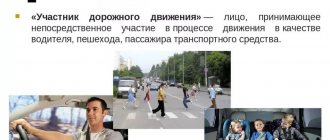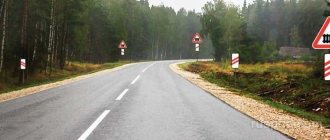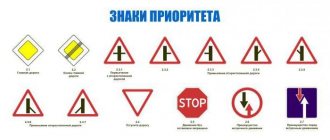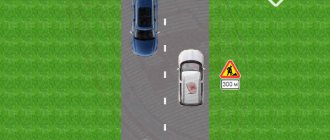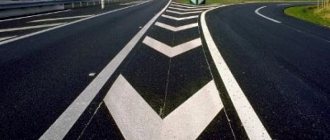Where can bike paths be built?
The standards for the design and construction of bicycle routes determine:
- SP 34.13330.2012 (formerly SNiP 2.05.02-85).
- SNiP II-K.3-62.
- GOST 33150-2014.
- SP 42.13330.2016 (updated edition of SNiP 2.07.01-89).
- VSN 25-86.
Single-lane pedestrian and bicycle paths on streets and parks
Bicycle paths can run along pedestrian sidewalks or on separate routes.
It is possible to build bicycle roads in green areas: city parks and forest parks. You can build cycling routes on embankments near rivers and seas. Their width is determined by standards.
Options for building bike paths:
- Separate road route.
- At the base of earthen embankments.
- On artificial embankments - berms.
Separate lanes for bicycles may be designated on roads. Their width is determined according to SP (SNiP), as well as GOST. The need for an additional lane arises if more than 100 cyclists pass on the road per hour. The traffic intensity should be up to 150 cars in 1 hour and up to 2000 cars in 24 hours.
Marking paths according to GOST
It is recommended to build single-lane roads on the windward side of the road. Two-lane - on both sides of the highway. (These are guidelines, not rules.)
The height of the curb that separates the bike path from the highway is 20–25 cm. When constructing a dividing strip, its width should be 0.7–1.5 m.
A bicycle lane on a sidewalk may be separate or accessible to pedestrians. Routes of the second type are called bicycle-pedestrian routes. The width of such a path is taken from 4 m.
Bicycle paths and traffic rules on them
A bicycle path in the vastness of the Russian Federation is sometimes a very relative concept.
By means both part of the road and part of the pedestrian sidewalk, and as practice shows, cyclists sometimes have to conquer their “territory” from both pedestrians and car drivers.
According to the rules, a bicycle path must be separated from the main traffic lane by a lawn, curb or special markings. But even if there are such, other road users use the road for cyclists at their own discretion.
Classification of bicycle paths
All bicycle paths are divided into the following types:
The one-way road is laid on both sides of the main road and is slightly elevated at its level. In some cases, in order to avoid larger vehicles from entering the bicycle path, its boundaries are designated as a buffer zone.
A two-way road for cycling usually runs along suburban or intercity routes. There are also options for two-way bicycle roads combined with or adjacent to a pedestrian zone. Also, a two-way path for cyclists is often found along one-way roads, highways along embankments, or near less extensive routes.
An isolated path for cyclists is a separate area and is intended exclusively for bicycle transport. Usually isolated paths are framed with high curbs to prevent the entry of motor vehicles. It is not uncommon to encounter pedestrians on isolated bike paths.
A combined bicycle road is rare in the Russian Federation and is indicated by a white line dividing the road for cyclists and pedestrians.
A compromise for cyclists and motorists
According to the global traffic system, first of all, bicycle lanes are indicated by road signs. Also, road signs may indicate a ban on the movement of bicycles, or warn drivers of motor vehicles about the possible movement of a two-wheeled vehicle.
In fact, there is no full regulation of traffic between motorists and cyclists, as well as a clear legislative framework regarding the relationship between drivers of four- and two-wheeled vehicles.
For example, there is a law banning any mechanical means on bicycle paths, except for bicycles themselves, but there is also an exception - vehicles of road maintenance and utility services have the right to enter the designated territory.
To prevent vehicles from entering the bicycle zone, artificial curbs (deliminators) are installed. Negligent drivers are fined 1.5 thousand rubles for driving into a restricted area and 2.5 thousand rubles for parking in a bicycle zone.
To summarize the above, we need to recommend that all road users be extremely careful on the roads and try to adhere to the traffic rules as much as possible.
Minimum width of a bicycle path in a park according to SNiP (SP)
The size of the bike lane depends on the volume of traffic. Construction codes and GOSTs regulating its width are presented in the table below.
| Bicycle path design | Bicycle path width according to GOST (m) | |
| In cramped conditions | When building from scratch | |
| Single-sided and single-lane | 0,75–1 | 1–1,5 |
| One-way and two-way | 1,5 | 1,75–2,5 |
| Two-way and two-lane (for oncoming traffic) | 2 | 2,5–3,6 |
The minimum width of a bicycle route is 0.75 m. This is the maximum minimum according to GOST 33150-2014, which determines the permissible lane size.
In the city
A two-lane bicycle path must be equal to or wider than 1.5 m. Two-way traffic is allowed with a traffic intensity of up to 70 bicycles in 1 hour. It is worth noting that the standard width of the route must be strictly observed in accordance with GOST.
Cycle paths - the world, UK, London
There is enough of an old photograph here - the mayor of the city (at that time, now prime minister) Boris Johnson at the opening of a dedicated bicycle path.
Cycle paths in London
Bicycles in the metro - Moscow, Russia, the world - what is the meaning of access for cyclists in the metro and what does it show
Bicycle on the sidewalk – Moscow, Russia, the world – rules and life
Review materials about cycling on Rulims
I. Bicycle as transport - use cases, seasonality, risks, (non) compliance with traffic rules, bicycles for moving around the city and other aspects of the urban cycling process
Table of contents:
Bicycle as transport – 2021
Bicycle in Russia – modern history
Bicycle in Russia – relations between road users
For whom and why is everything described?
Introductory illustration where everything is perfect
I. Options for using a bicycle as transport, main models of using a bicycle in the city
II. What is a bike ride?
Cycling route
Travel speed
Weather conditions for cycling
Bicycle in winter (at sub-zero temperatures)
III. State of the environment
IV. Bicycle and traffic rules
V. Bicycle on the sidewalk
VI. Cyclists and pedestrians
VII. Motorists and cyclists
VIII. Cyclist safety
IX. Russian cycling culture
X. Adequacy of various road users
II. Cyclist in Moscow - positioning the bicycle as a mass (all-season) transport - incompetence, criminal intent or what?
Table of contents:
Illustration and commentary: cycling from officials
Illustration and commentary: m cyclist - for whom budgets for cycling infrastructure are being allocated
Stages of development of the modern cycling process in Moscow
Cyclist in Moscow - since 2012 - team cycling from above
Phantom bike paths - a sly start
Cyclist in Moscow - features, road infrastructure of the city
Moscow metropolis – size and population
Moscow public transport
Cyclist in Moscow – bike rental
Cyclist in Moscow – state of the environment, air quality in Moscow
A cyclist in Moscow - who is he - the target audience for the development of cycling infrastructure in Moscow
Cyclists in Moscow – number of cyclists
Cycling at whose expense
Cyclist in Moscow - risks
Cycling in Moscow - what's next - examination
The bike path on Lesnaya Street in Moscow, as a typical example of team cycling
III. Traffic regulations for a cyclist, is it possible to ride strictly according to traffic regulations, a bicycle on a sidewalk-pedestrian path
Table of contents:
Traffic rules for a cyclist - texts of the main chapters
Cyclist traffic rules - general provisions
Traffic rules of the Russian Federation, 24. Additional requirements for the movement of cyclists and moped drivers
Traffic rules and cyclist on the sidewalk, cyclist and pedestrians
Read on Rulims on the topic
Studying traffic rules (realities of road situations)
SDA exam (Road Rules)
Why the theory exam at the traffic police will create problems for many people...
Studying traffic rules online - taking a theory course in a driving school online (via the Internet) and online preparation for exams in the traffic police
To drive a bicycle you do not need a driving license in Russia, but to drive a scooter you need to obtain a driving license:
Categories and subcategories of a driver's license, opening a new or several categories, what kind of driving license can be obtained at 16 years old
Why it is better not to delay obtaining a driving license in 2020:
When is the best time to get a driver's license in 2021?
How to get a driver's license (licence) quickly (in 3-4 months) in 2021
Situations on the road that are important for all road users to be familiar with:
Hitting a pedestrian is the worst nightmare of a driver, especially a beginner, what drivers and pedestrians need to know
Pitfalls (ambiguous situations on the road that you may encounter during exams and in life)
Set-ups on the road (imitation of an accident) with fraudulent pedestrians, several criminal schemes, everyone needs to know!
Rulims also explains in detail how to interact with Russian healthcare in order to receive adequate medical care. Plus, all the main issues related to the coronavirus epidemic are covered in detail - from how you can really protect yourself (there are no adequate medicines and vaccines and there definitely won’t be until the end of 2021, only preventive measures work) to what tests are available for coronavirus.
Medicine and healthcare of Russia on Rulims
Published 07/24/2020, version 0.94 from 07/25/2020
Author: Alexander Rulim (Sasha Rulim)
Support Rulims!
If Healthcare Chronicles and Rulims helped you or allowed you to save on something, help him too! I will be grateful for any amount. You can transfer either from a bank card or from Yandex.Money (you must select the desired payment method). The funds received will allow us to develop the resource, raise new topics and possibly offer new services.
If you cannot use the proposed translation methods, please support the Charitable Foundation Tradition, which is close to me. They have access to almost all available methods of receiving funds.
You can also help by publishing a link to the material or to Rulims (https://www.rulims.ru) on your favorite social network, blog or forum. I would be especially grateful for blogs and forums, thank you very much in advance. I will also be grateful for participation in Rulims groups on social networks. And I am extremely grateful for the reposts of interesting materials on your blogs and forums. Comments and examples from your experience are also very useful for the development of the project. To comment, it is better to register on Rulims. The registration form on the site is as simple as possible. Services are provided for registered users only.
You can read more about how you can help the resource on the Support and participation in the project page.
Standards for distance to other objects
In parks, SNiP (SP) regulates not only the width of bicycle routes. The standards also define the minimum distances between separate bicycle paths and other objects (in meters):
- Sidewalk – 0.5.
- The edge of the road is 0.75.
- Trees – 0.75.
- Car parking – 1.5.
- Stopping any type of transport – 1.5.
Sketch of a single-lane bike path
Regulations for the construction of bicycle paths ensure the safety of cyclists.
They reduce the risk of serious injury if you lose control and fall off your bike. Rules for designing bicycle paths also ensure the safety of pedestrians. The width of these tracks is an important indicator.
When a bike path crosses a water hazard in a park or forest park, a bridge must be built. The height of fencing on a bridge over a ditch, stream or ravine should be 1.3 m or more, regardless of the width of the crossing.
What is a bike path
A bicycle path can be a separate road or a limited section of the roadway. It must be separated from the main route by a curb, lawn, special markings or other means of fencing.
There are several types of bicycle paths:
- One-way - located on both sides of the highway. Sometimes they are raised slightly above the road level, making it difficult for motorists to enter areas reserved for cyclists. Cycle paths of this type are often found in European countries, including Denmark and Holland. In the USA, one-way paths are additionally separated from the highway by a buffer zone, which increases the level of safety and comfort.
- Two-way - usually created in the suburbs and on intercity highways. As a rule, they are located in close proximity to the sidewalk or combined with it. The use of such cycle paths is also suitable for embankments and roads that have branches on only one side.
- Isolated - fenced off from the main flow of vehicles with high curbs or pedestrian barriers. If there is no pedestrian zone within walking distance of such a path, then people without transport are allowed to use it.
- Combined - found only in the CIS countries. They represent a defined line on the sidewalk and are only a semblance of a bicycle path in its traditional sense.
Road intersection zones
Intersections should be located on a straight section of both routes. This should be an area with good visibility and minimal slope. At intersections, road signs are installed in accordance with traffic regulations.
Standard road width in the city according to SNiP and GOST standards
A traffic light must be installed at the intersection of the bicycle path and the highway. The road intersection area should be well illuminated with lanterns. The length of the illuminated section of the route should be from 60 m.
Proper marking for a bike path
The bike path in the park must be constructed of asphalt concrete, cement concrete or other stone material. For construction, the use of gravel, crushed stone, broken bricks, slag and burnt rocks is allowed. Modern bike paths are covered with a modular or seamless coating of crumb rubber.
On a note
The route for cyclists is marked:
- pavement markings;
- road signs;
- fencing (only on roads);
- height of the relief - raising the level of the canvas.
The surface of the bike path is treated with binders. They reduce slipping and reduce the likelihood of accidents.
When a bike path runs parallel to a pedestrian or car route, it is highlighted in color. If there is a distance between two roads, it is filled with lawn, flower beds, shrubs, and tree plantings.
Typical minor street width
It is not advisable to use thermoplastic for painting and marking bicycle paths. When it rains it becomes slippery.
Old plastic is difficult to remove from the canvas when updating the markings. The remains of old plastic form a relief that impairs the control of the bicycle.
Subtleties
Modern technologies make it possible to paint asphalt at the stage of its production. To do this, pigments are added to the solution. An alternative to thermoplastics are durable paints that can be used to paint asphalt.
Purpose of dimensions of bicycle paths
Images of bicycles are applied to the canvas. The distance between two drawings should be from 100 to 150 meters. In the area where bicycle and pedestrian paths intersect, a zebra crossing or an image of a person is painted.
Yellow relief slabs are not allowed on bike paths. Such plates serve to orient blind and visually impaired people. Relief slabs should be laid on the sidewalk in the transition area.
Pedestrians on bicycle and pedestrian paths
4.1. Pedestrians must move on sidewalks or pedestrian paths, or, if there are none, along the roadsides. Pedestrians carrying or carrying bulky objects, as well as persons using non-motorized wheelchairs, may walk along the edge of the roadway if their movement on sidewalks or shoulders creates an obstacle for other pedestrians.
If there are no sidewalks, pedestrian paths or shoulders, or if it is impossible to move along them, pedestrians may move along a bicycle path or walk in a single file along the edge of the roadway (on roads with a dividing strip, along the outer edge of the roadway).
4.1. Pedestrians must move on sidewalks, pedestrian paths, bicycle and pedestrian paths, and, if there are none, along the roadsides. Pedestrians carrying or carrying bulky objects, as well as persons using non-motorized wheelchairs, may walk along the edge of the roadway if their movement on sidewalks or shoulders creates an obstacle for other pedestrians.
If there are no sidewalks, pedestrian paths, bicycle paths or shoulders, and also if it is impossible to move along them, pedestrians can move along a bicycle path or walk in one row along the edge of the roadway (on roads with a dividing strip - along the outer edge of the roadway).
The updated paragraph 4.1 of the rules puts bicycle and pedestrian paths on a par with sidewalks and pedestrian paths. Pedestrians must move along them. And only if there is no pedestrian path, no bicycle path, no sidewalk, no curb nearby, pedestrians can go onto the bicycle path or roadway.
Note. Starting from December 8, 2018, paragraph 4.1 of the traffic rules has been updated.
Regulations for bicycle parking
Parking for bicycles can be provided in parks and forest parks. Bicycle parking should be located near public catering establishments and places of short-term recreation for people.
Near residential buildings
Distance standards for parking bicycles:
- the interval to the nearest wall is 0.6 meters;
- lateral distance between posts – 0.76 m;
- the distance between parallel posts is 1.2–2.6 meters.
Open parking lots are most often organized in parks. They are formed by one or more posts. Bike racks can be covered with a rain cover. But this is not a prerequisite for organizing parking.
Rules for driving on paths for cyclists
Cycle paths are intended for users over 14 years of age. Children under 7 years of age must ride on sidewalks even where there is a bike lane.
Two-lane bicycle path in accordance with GOST and SNiP (SP) standards
This limit is set for the safety of children and to equalize the flow rate. Children aged 7 to 14 years have the right to choose a route: a bike path or a sidewalk.
On paths, cyclists are advised to maintain a distance of 0.8–1 m.
The distance makes overtaking easier and makes maneuvers safer when the track width is limited. Loads more than 1 m wide cannot be transported on bicycle paths.
Moped drivers are allowed to use bicycle lanes. When maneuvering, cyclists have an advantage over moped drivers according to traffic regulations. All road users are required to use reflective elements at night.
Pedestrian and bicycle pedestrian path signs
4.5 "Footpath". Only pedestrians are allowed to move.
4.5.1 "Footpath". Pedestrians and cyclists are allowed to move in the cases specified in paragraphs 24.2 - 24.4 of these Rules.
4.5.2 “Pedestrian and bicycle path with combined traffic (cycle and pedestrian path with combined traffic).
4.5.3 “The end of a pedestrian and bicycle path with combined traffic (the end of a bicycle and pedestrian path with combined traffic).”
4.5.4, 4.5.5 "Pedestrian and bicycle path with traffic separation." A bicycle and pedestrian path with a division into bicycle and pedestrian sides of the path, allocated structurally and (or) marked with horizontal markings 1.2, 1.23.2 and 1.23.3 or in another way.
4.5.6, 4.5.7 “The end of a segregated pedestrian and cycle path (the end of a segregated cycle and pedestrian path).”
Previously, the rules included the only road sign “Pedestrian path”, but starting from April 8, 2014, 6 new signs were added to it:
Signs 4.5.2 and 4.5.3 indicate, respectively, the beginning and end of a bicycle and pedestrian path with combined traffic . Please note that this path contains a mix of cyclists and pedestrians. This is inconvenient for both.
The shared path is suitable for cyclists of all ages.
Signs 4.5.4 - 4.5.7 indicate a bicycle and pedestrian path with traffic separation . On such a path, the flows of cyclists and pedestrians are separated from each other either structurally or by marking lines.
Please note that segregated paths are also open to all cyclists. However, cyclists over 7 years of age must use the bicycle portion of the path, and cyclists under 7 years of age must use the pedestrian portion of the path.
